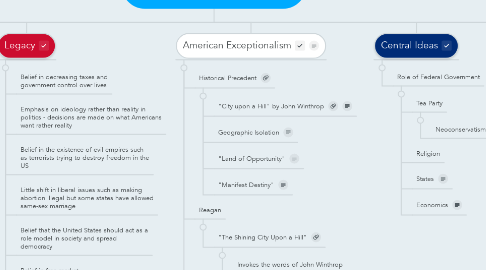
1. Central Ideas
1.1. Role of Federal Government
1.1.1. Tea Party
1.1.1.1. Neoconservatism
1.1.2. Religion
1.1.3. States
1.1.4. Economics
2. Significant Historical Figures (possible choices)
2.1. Reagan
2.1.1. The Model Conservative
2.1.2. "Reaganomics"
2.1.2.1. Trickle-down Economics
2.1.2.2. The Four R's: Reduce, Reduce, Reduce, and Reduce
2.1.2.2.1. Tax Reform Act of 1986
2.1.3. Reagan Doctrine
2.1.3.1. Realities of Reaganomics
2.1.3.2. The "Evil Empire"
2.2. W. Bush
2.3. H.W. Bush 1989-93
2.3.1. Religious
2.3.1.1. Bush was raised an Episcopalian and a Presbyterian. However, in 1985, he converted to the Methodist faith.
2.3.1.2. http://www.nytimes.com/2004/10/17/magazine/17BUSH.html?_r=0
2.3.1.3. Thought himself to pursue a mission from god.
2.3.2. Born in Conneticut and raised in Texas
2.3.3. Political View: Compassionate Conservatism
2.3.3.1. a political philosophy that stresses using traditionally conservative techniques and concepts in order to improve the general welfare of society.
2.4. Nixon
2.5. Clinton
2.5.1. Anti-conservative
2.6. Michael Harrington
2.6.1. A socialist who popularizes the idea for neoconservative.
3. Legacy
3.1. Belief in decreasing taxes and government control over lives
3.2. Emphasis on ideology rather than reality in politics - decisions are made on what Americans want rather reality
3.3. Belief in the existence of evil empires such as terrorists trying to destroy freedom in the US
3.4. Little shift in liberal issues such as making abortion illegal but some states have allowed same-sex marriage
3.5. Belief that the United States should act as a role model in society and spread democracy
3.6. Belief in free market
3.7. Affirmative action still allowed to exist
4. Additional Information (Who? What? Where? When? Why? and How?)
4.1. What
4.1.1. According to Gold Water's Essay
4.1.1.1. based upon the principle that freedom is the ultimate maxim of human existence
4.1.1.2. Essential components: personal responsibility for one's actions and the protection of individual freedom
4.1.1.3. conservatives are spiritual beings not just economic
4.1.1.4. government should be as limited as possible
4.1.2. to preserve/restore traditional values and limit change
4.2. When
4.2.1. always had older roots in American history
4.2.2. modern movement began in mid-1930s
4.2.3. 1960s: conservatism strengthened
4.2.4. 1980s: Republican conservatism strength solidified
4.2.4.1. Ronald Reagan/neoconservatives
4.2.4.2. 1960s: Democrat -> Republican Party
4.2.5. 2009: Tea Party Movement
4.3. Why
4.3.1. Why: intellectuals/politicians/businessmen opposed the New Deal's liberalism , labor unions, democracy
4.3.2. Originally conservative Southerners didn't approve of the Democratic Party's fight for civil rights.
4.4. How
4.4.1. 1964 election between Berry Goldwater and Lyndon Johnson
4.4.2. 1980 election
4.4.2.1. smaller federal gov, deregulation of business, lower taxes, strong national defense against communism.
4.5. Who
4.5.1. Ronald Reagen
4.5.2. Berry Goldwater
5. Reagan's First Inaugural Address [WORDLE] (Please read the note!)
5.1. WORDLE Cloud
5.2. Key Words
5.2.1. Americans
5.2.2. Freedom
5.2.3. Theme: American Exceptionalism
5.2.3.1. World
5.2.3.2. Nation
5.2.4. Theme: Conservative Values
5.2.4.1. Believe
5.2.4.2. Government
5.3. Issues
5.4. Goals
6. American Exceptionalism
6.1. Historical Precedent
6.1.1. "City upon a Hill" by John Winthrop
6.1.2. Geographic Isolation
6.1.3. "Land of Opportunity"
6.1.4. "Manifest Destiny"
6.2. Reagan
6.2.1. "The Shining City Upon a Hill"
6.2.1.1. Invokes the words of John Winthrop
6.2.1.2. Uniqueness of American Constitution
6.2.1.3. "We are indeed, and we are today, the last best hope of man on earth."
6.2.1.4. Exalts American contributions and lifestyle
6.3. Oklahoma: AP U.S. History Ban
7. Never Trust Your Teachers
7.1. Stanley Milgram: The Milgram Experiment
7.1.1. Background
7.1.1.1. Setup
7.1.1.2. Procedure
7.1.1.2.1. Contingency
7.1.1.3. Results
7.1.2. Questions
7.1.2.1. 1. Who were the test subjects?
7.1.2.2. 2. What was the role of the person who conducted the experiment?
7.1.2.3. 3. What was the setting of the experiment?
7.2. Ron Jones: The Third Wave
7.2.1. Background
7.2.1.1. Setup
7.2.1.2. Development
7.2.1.3. Results
7.2.2. Questions
7.2.2.1. 1. Who were the test subjects?
7.2.2.2. 2. What was the role of the person who conducted the experiment?
7.2.2.3. 3. What was the setting of the experiment?
7.2.2.4. 4. What was the specific question the experiment 'was supposed to' answer'?
7.3. 4. What was the specific question the experiment 'was supposed to' answer'?
7.4. Jane Elliott: Blue-eyes, Brown-eyes
7.4.1. Background
7.4.1.1. Setup
7.4.1.2. Procedure
7.4.1.3. Results
7.4.2. Questions
7.4.2.1. 1. Who were the test subjects?
7.4.2.2. 2. What was the role of the person who conducted the experiment?
7.4.2.3. 3. What was the setting of the experiment?
7.4.2.4. 4. What was the specific question the experiment 'was supposed to' answer'?
7.5. General Questions
7.5.1. 1. What did these experiments prove?
7.5.2. 2. Knowing the tumultuous character of the 1960s - 1970s, to what extent do these experiments reflect the views of the period?
8. Significant Event- California Proposition 8
8.1. Origin
8.1.1. Created in response to "In re Marriage Cases"
8.2. Supporters
8.2.1. Political figures
8.2.1.1. John McCain
8.2.2. Religious organizations
8.2.2.1. Mormons
8.2.3. Arguments
8.2.3.1. Claims that it protected the free expression of religion.
8.2.3.2. "Protected" children from being taught in public schools that same-sex marriages were as legitimate as marriages between two people of opposite genders.
8.3. Opposition
8.3.1. Political figures
8.3.1.1. Barack Obama
8.3.2. Religious organziations
8.3.2.1. California Council of Churches
8.3.3. Arguments
8.3.3.1. "Equal protection under the law is the foundation of American society."
8.3.3.2. Traditional marriage itself degrades the institution of marriage. About 50% of heterosexual marriages ends in divorce.
8.4. Legal Challenges
8.4.1. Perry v. Brown
8.4.2. Ninth Circuit ruling
8.5. Aftermath
8.5.1. Same-sex couples that were already married weren't affected; their marriages were still valid.
8.5.2. Prop 8 was later lifted and same-sex marriages continued.
9. Context
9.1. Time
9.1.1. Characteristics
9.1.1.1. Hostility Towards Communism
9.1.1.1.1. Détente
9.1.1.2. Opposition to "big government"
9.1.2. Social Conservatism (1970-present)
9.1.2.1. Opposition to many progressive movements
9.1.2.2. Opposition to Rights Movements
9.1.2.2.1. Gender Equality
9.1.2.3. Sexual Revolution
9.1.3. Economic Conservatism (1930-present)
9.1.4. Timeline of Events
9.1.4.1. Obama (2009-Present)
9.1.4.1.1. Rise of the Tea Party (2009)
9.1.5. W. Bush (2001-2009)
9.2. Place
9.3. Circumstances
9.3.1. The "Good Old Days"
